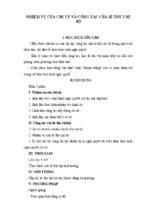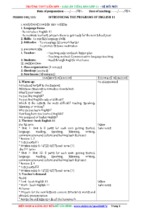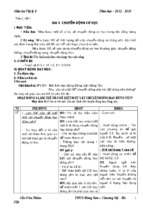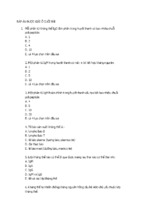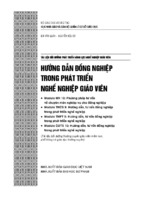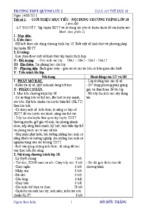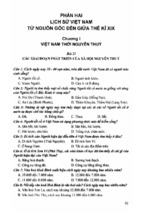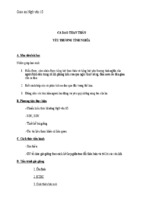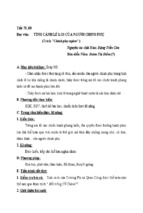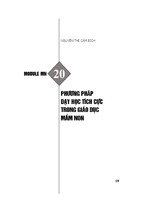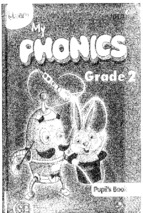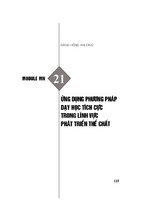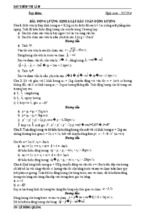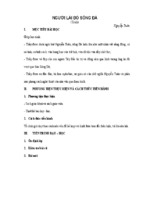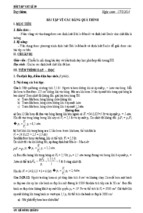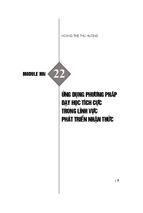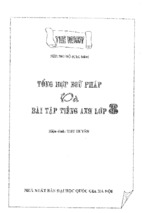Planning of date: 24/8/2014
Teaching of date : 25/8/2014 Class 10B1
26/8/2014 Class 10A
Period 1 Ôn tập và kiểm tra
I. Aims :
- To introduce the textbook- English 10
- To introduce the way of testing.
- To set up some class regulations.
- To give a fifteen- minute test.
II. Procedures:
1. Textbook introduction:
a. Contents: - Six themes:+ You and me
+ Education
+ Community
+ Nature and the environment
+ Recreation.
+ People and places.
- Sixteen units.
b. The Structure of the book: - There are sixteen units . In each unit , there are five main
parts: Reading, Speaking, Listening, Writing
+ Language focus: - Pronunciation
- Grammar and vocabulary.
2.Review grammar
TENSES
SIMPLE PRESENT
(HIỆN TẠI ĐƠN)
Động từ “tobe”:
S + am/ is / are + …
S + am / is / are + not + …
Am / Is / Are + S + …?
Động từ thường:
S + V1 / V(s/es)
S + don’t/ doesn’t + V1
Do / Does + S + V1 …?
PRESENT PROGRESSIVE
(HIỆN TẠI TIẾP DIỄN)
S + am/is/are + V-ing
S + am/ is/ are + not + V-ing
Am / Is /Are + S + V-ing?
* Dấu hiệu nhận biết:
- always, usually, often, sometimes, seldom,
rarely, never, every, normally, regularly,
occasionally, as a rule …
* Dấu hiệu nhận biết:
- at the moment, now, right now, at present
- Look!
- Listen!
- Be quiet!
- Keep silent!
PRESENT PERFECT
(HIỆN TẠI HOÀN THÀNH)
S + has / have + P.P
S + has / have + not + P.P
Has / Have + S + P.P?
* Dấu hiệu nhận biết:
- lately, recently (gần đây)
- so far, up to now, up to the present (cho tới
bây giờ)
- in the past (ten) years (trong mười năm qua)
- in the last (years) (những năm gần đây)
- all my / his / her / their … life
- already, ever, never, just, yet, for, since.
- how long …
- this is the first time/second time…
- many times / several times …
SIMPLE PAST
(QUÁ KHỨ ĐƠN)
Động từ “tobe”:
S + / were + …
S + wasn’t / weren’t + …
Was / Were + S + …?
Động từ thường:
S + V2 / V-ed
S + didn’t + V1
Did + S + V1 ….?
PAST PROGRESSIVE
(QUÁ KHỨ TIẾP DIỄN)
S + was / were + V-ing
S + was / were + not + V-ing
Was / Were + S + V-ing…?
* Dấu hiệu nhận biết:
- yesterday, last week, last month, …ago, in
1990, in the past, …
PAST PERFECT
(QUÁ KHỨ HOÀN THÀNH
S + had + P.P
S + hadn’t + P.P
Had + S + P.P …?
* Dấu hiệu nhận biết:
- already, ever, never, before, by, by the time,
after until, when, ….
* Dấu hiệu nhận biết:
- at that time, at (9 o’clock) last night, at this
time (last week), in the summer, during the
summer, all day, all week, all month, …
Dạng bị động:
a.Cấu trúc câu:
Subject + be + past participle + by + agent
This house was built by my grandfather
b.Áp dụng: câu bị động thường được dùng
khi không biết hoặc không cần biết đến người hoặc vật thực hiện hành động
vd: The street are swept everyday ( by street-sweepers)
khi muốn nhấn mạnh người hoặc vật tiếp nhận hành động
vd: the painting was painted by my dad
Muốn chuyển đổi câu chủ động sang câu bị động ta thực hiện bước sau:
1.Lấy tân ngữ của câu chủ động làm chủ ngữ của câu bị động
2.Đổi động từ chủ động thành động từ bị động ( be + P.P)
3.Exercise 20’
I.Choose the best answer to complete each sentence below.(5marks)
1.. I..................much of you lately. We..........................three months ago
A. haven’t seen- last meet
B. didn’t see- met C. haven’t seen- have meet D. didn’t seehave met
2. She................Hanoi last year
A. went
B. go
C. goes
D. is going
3. When Carol....................last night, I................my favorite show on television
A. was calling- watched B. called- have watched C. called- was watching D. had calledwatched
4. Right now, Jim.................the newspaper and Kathy...............dinner
A. reads- has cooked B. is reading- is cooking C. has read- was cooking D. read- will be
cooking
5. Last night at this time, they..................the same thing. She.................and he............the
newspaper
A. are doing- is cooking- is reading
B. were doing- was cooking- was reading
C. was doing- has cooked- is reading
D. had done- was cooking- read
6. Every day I ____up at 6 o’clock, _______breakfast at seven o’clock and_______for work at 8
o’clock
A. get- eat- leave B. have got- eating- leaving
C. got- ate- left
D. will get- have
eaten- left
7. Up to now, the manager ………………..a lot of information about his secretary.
A. learned
B. has learned
C. had learned
D. learns
8. While I ……………….along the road, I saw a friend of mine.
A. was cycling
B. have cycled
C. cycled
D. am
cycling
9. He ………….. in the same house since 1975.
A. has lived
B. is living
C. lived
D. had lived
10.When we arrived at the restaurant, the others __________ .
A. left
B. have left
C. had left
D. are
leaving
II. Change the following sentence into the passive sentence(5marks)
1. They are building a new pool.
2. They have discovered oil at the North Pole
3. The police stopped us on our way home
4. She was cooking dinner at that time
5.They had destroyed all the documents when he arrived.
4.Consolidation :
5.Homework: 2’
a, Old lesson
b, New lesson
- Have Ss prepare reading unit 1
*Comment:
1.The time:……………………………………………
2. Content:……………………………………………
3. Methods:…………………………………………….
Planning of date: 24/8/2014
Teaching of date : 26/8/2014 Class 10B1
28/8/2014 Class 10A
A DAY IN THE LIFlE OF ………………..
Period 2 Reading
I. Aims :
1- Knowledge :
- General knowledge : Students should know how to do their daily activities
effectively and be in love with their work.
- Language :
- Sts can learn some new words related to farming , the daily activities
- Sts can read for gist and for information and summarize the content of
the reading.
2- Skills : reading for gist, reading for details.
3- Educational aim :
o By the end of the lesson , the Ss will be able to understand farmers'
activities and talk about the daily routines and the. love of the work
II.Teaching aids:
1. Pupils: Text and note book, prepare some pictures in the textbook.
2. Teacher: Text book, lesson plan, and handout.
III . Procedure
1.Oral test: 5’
a,Questions:
Please you introduce about yourself
1.What is your name ?
2.How old are you ?
3.How many people are in your family ?
b, Answers and mark
1.My name …..
2. I’ am …..
3. There are ……. people in my family
2.Warm-up: 4’
Stick the picture of the farmer on the bb and ask Sts about it.
What is his job?
Where does he work?
Can you tell me what a farmer usually does every day?
Look at it and answer the questions
Speak out the answers
* Brain-storming:
Get up
go to the field
DAILY ACTIVITIES OF A FARMER
* Introduce the new lesson
3. New lesson:
Teacher’s activities
Pre- reading:7’
- pre-teach new words:
o Lead the buffalo to the
field:
o Plough (v). (n):
o Harrow (v), (n):
o Pump water (v) :
o Transplant (v):
o Peasant (n) :
- Ask Sts to read the new words and
write down
- Deliver the handouts to Ss
Handout.
leading the buffalo to the field,
singing karaoke, doing homework ,
ploughing and harrowing,
transplanting, teaching English ,
pumping water into the land, getting
up early, preparing lesson plan,
chatting with friends, drinking tea.
- Ask Ss to look at the hand out
- Read the activities and ask Ss to
repeat
- Ask Ss to pick out some activities
which
farmers usually do.
- Ask Ss to give their chosen ones.
- Check the information chosen by
the groups in
front of the class.
- Give feedback
While-reading:
- Ask Ss to read the text
Students’ activities
- Guess the words and give their meanings
by
looking at the pictures:
o Lead the buffalo to the field:
o Plough (v). (n):turn up the soil
(caøy)
o Harrow (v), (n):break the
soil(bừa)
o Pump water (v) : bôm nöôùc
o Transplant (v):grow rice
( caáy)
o Peasant (n) :noâng daân
- Take notes
- Get the handout
- Look at the hand out
- Repeat them after teacher
- Do the task: Ss work in groups and choose
some
- The representatives of some groups
present
their information.
Suggested answers
(Ss’ answers may vary)
leading the buffalo to the field,ploughing
and harrowing, transplanting, pumping
water into the land, getting up early,chatting
with friends, drinking tea.
- Read the passage silently and quickly.
- Ask Ss to work in groups to check
the
information
- Go around to help them to do the
task if
necessary
- Ask Ss to give their answers again
- Give feedback.
Activity 1.(Task 1) 6’
- Run through the requirement
- Ask Ss to do the task in pairs
- Monitor class
- Ask Ss to say their chosen answers.
- Give feedback
- Work in groups and get the correct
information
for their choices
- Give their answers
- Take notes
- Read the reading again
- Work in pairs
- Give their answers.
- Take notes
Suggested answers:
1.C
2.C
3.A
4. A
Activity 2.(Task 3) 8’
- Explain the instruction
- Ask Ss to work in groups
- Ask Ss to scan the passage again
and get the
information to fill in the chart.
- Entrust each group with a specific
task.
- Ask Ss to give their answers
- Do as directed in groups
- One completes the column “in the
morning”;
the other with “in the afternoon”; the rest
one
with “after dinner”.
- Show the posters with their answers.
4:30: the alarm goes off and
Mr Vy gets up, goes down
the kitchen, boils water for
tea, drinks tea, has quick
breakfast, leads buffalo to
In the
field
morning 5:15: leaves house
5:30: arrives in the field,
ploughs and harrows
7:45: takes a break
10:30: goes home
11:30: has lunch with family
In the
2:30pm: Mr. Vy and Mrs.
afternoon Tuyet go to the field again,
repair the banks of the plot
of land. He pumps water into
After
dinner
- Give feedback
the plot of land. She does
transplanting.
6:00pm: finish work
7:00pm: have dinner
Watch TV, go to bed
Sometimes visit neighbours,
chat with them.
- Listen to the teacher
Activity 3.(Task 2) 7’
- Ask Ss to tell what they are going
to do in task 2.
- Run through the questions in task 2
- Ask Ss to reread the passage and
answer them in groups
- Go around and monitor.
- Ask some pairs to practice in front
of class.
- Reread the passage
- Work in pairs
- Answer the questions
- Practice in pairs (one asks; another
answers)
1.
2.
3.
4.
5.
Suggested answers:
He’s a peasant/ farmer.
He gets up at 4:30 and then goes
down the kitchen to boil some water
for his morning tea.
In the morning, he ploughs and
harrows his plot of land, drinks tea,
and smokes tobacco during his break.
In the afternoon, thay repair the banks
of the plot of land. Mr. Vy pumps
water into it and his wife does the
transplanting.
Yes, they are. Because they lovfe
working and they love their children.
- Give feedback
Post reading: 5’
- Ask Ss to work in groups and talk
about Mr. Vy
and Mrs. Tuyet’s daily routines
- Ask the representatives of some
groups to
present their talks in front of the
class.
- Comment Ss’ presentation/Give
feedback
- Work in groups
- Present them individually
4.Consolidation : 2’
T goes over the way used to describe daily routines.
In the morning. I get up at 5:30 , have breakfast and then go to school
5.Homework: 2’
a, Old lesson
- Ask Sts to write a short passage about Mr. Vy
and Mrs. Tuyet’s daily routines.
- Suggest Ss’ homework
Fulfill their tasks at home
b, New lesson
- Have Ss prepare “speaking” for the next period.
*Comment:
1.The time:……………………………………………
2. Content:……………………………………………
3. Methods:…………………………………………….
Planning of date: 24/8/2014
Teaching of date :30/8/2014 Class 10A,10B1
Unit 1 A DAY IN THE LIFE OF ………………..
Period 3 Speaking
I. Aim
1- Knowledge :
- General knowledge : Students should know how to do their daily activities
effectively and be in love with their work.
- Language :
+ Ss can learn some new words related to farming , the daily activities …
+ Ss can read for gist and for information and summarize the content of the reading.
2- Skills : asking for and giving information from a timtable; taking about daily.
3- Educational aim :
By the end of the lesson , the Ss will be able to understand farmers' activities and talk
about the daily routines and the love of the work
II.Teaching aids:
2. Pupils: Text and note book, prepare some pictures in the textbook.
3. Teacher: Text book, lesson plan,
III . Procedure
1.Oral test: 7’
a,Questions:
Let's talk about your daily routine
b, Answers and mark
I get up at 5:30 , have breakfast and then go to school.Every afternoon I get up at
14:00. then I study for about two hours. I watch TV at 16:30. at 17:00 I rides to the
stadium to play football with other boys in the neighborhood. I get back home at
18:30. after having a shower at 18:45, I have dinner with my family at 19:00. I study
the lessons at 20:00.
2.Warm-up: 5’
- Show a poster:
M....
.....ture .....ics Ch.....
....logy .....ish Geo.
His…
Ask pupils to work in groups, write the subjects, and then read them.
- Work in groups
- Write the subjects on the board.
Suggested answers
Mathematics,Literature, Physics,Chemistry,Biology,English,Geography, History
- Listen and repeat
- Feedback.
- Ask Ss to repeat after teacher
3. New lesson:
Teacher’s activities
Students’ activities
Pre – speaking: 9’
Task 1:
- Remind pupils of the way to tell time by
giving them some handouts, then ask them - Work in pairs
to match a number in column A with
suitable expressions in column B:
- Do the matching.
A
B
1. 6:00
a. a quarter to ten
2. 7:15
b. five to nine
3. 8:05
c. five past eight
4. 8:55
d. a quarter past
5. 9:45
seven
6. 10:40
e. twenty to eleven
7. 17:00
f. half past six p.m
g. five p.m
h. six a.m
- Ask Ss to work in pairs to do the task
- Go around and monitor class
- Ask Ss to go to the board to do the
task as directed
- Give feedback
Suggested answers:
1.h
2.d
3.c
4.b
5.a
6.e
7.g
- Correct the mistakes
- Listen and answer
+ It’s .......
+ I usually get up at .......
+ ...............
- Ask pupils some questions about
their real lives:
+ What time is it ? = What is the
time?
- Look at task 1 page 14, 15
+ What time do you get up ?
+ What time do you go to school ?
- Practise the conversation with
+ What do you do at … ?
- other subjects
- Give pupils clear instructions and
and time-points.in pairs.
model conversations:
- Present in front of class
A: What time does Quan have a Civic
Education lesson on Monday ?
B: (He has a ... ) at 7: 15 a.m.
A: What lesson does Quan have at 7:15
a.m on Monday ?
B: (He has) a Civic Education lesson at
7:15.
(Teacher & pupils – Pupils & Pupils)
- Ask Ss to work in pairs to practice
speaking
- Ask Ss to practice in front of class
- Give feedback
While-speaking: 10’
Task 2
- Ask pupils to look at the pictures and
make a sentence to describe each
- Work in groups to talk about
- the pictures in
the textbook
picture in groups.
- Go around and help pupils.
- Ask some students to speak in front
of the class.
- Comment Ss’ presentation
Post-speaking: 10’
Task 3:
- Give pupils some cues by asking
quetions.
“ what do you usually do at …………?”
- Ask pupils to work in groups and talk
about their daily routines.
- Comment Ss’ presentation/ Give
feedback
- Speak in front of the class
Suggested answer
Every afternoon Quan gets up at 14:00.
then he studies for about two hours.
He watchs TV at 16:30. at 17:00
he rides to the stadium to play
football with other boys in
the neighborhood. He gets back
home at 18:30. after having a shower
at 18:45, he has dinner with his
family at 19:00. He studies the
lessons at 20:00.
- Tell their friends about their
daily activities.
Suggested answers
“ I usually get up at 5:00. then I
have breakfast. At 6:30, I go to school.
…..”
- Tae notes
4.Consolidation: 2’
Go over the ways of asking and giving information from a table and
talking about daily routine.
I usually get up at 5:00. then I have breakfast. At 6:30, I go to school. …..”
5.Homework: 2’
a, Old lesson
- Emphasize on the timepoints in a day.
Write a short paragraph about their daily activities (about 80 words)
b, New lesson
- Prepare the next lesson (C. Listening on page 16, 17)
*Comment:
1.The time:……………………………………………
2. Content:……………………………………………
3. Methods:…………………………………………
Planning of date: 1/9/2014
Unit 1
Teaching of date : 4/9/2014Class 10A,10B1
A DAY IN THE LIFE OF ………………..
Period: 4 Listening
I. Aim:
1. Knowledge
- General knowledge: Ss can be able to know about activities of a cyclo
driver.
- Language: New words related to activities of a cyclo driver.
2. Skills: Listening for gist, listening for details , speaking.
3. Educational aim: By the end of the lesson , the Ss will be able to understand
farmers' activities and talk about the daily routines and the
love of the work
II.Teaching aids:
4. Pupils: Text and note book, prepare some pictures in the textbook.
5. Teacher: Text book, lesson plan, cassette, ect
III . Procedure
1.Oral test: 5’
a,Questions:
1 What time is it ? = What is the
time?
2. What time do you get up ?
3. What time do you go to school ?
b, Answers and mark
1. 9 : 00 am
2. I get up at …
3. I go to school at …
2.Warm-up: 5’
- Stick the poster on the board
- Ask Ss to look at the poster and read the
instruction
- Get Ss to work in pairs to supply activities of a cyclo driver
- Get Ss to go to the board to do the task
- Give feedback
Pick the passengers up
take the passengers to
- Look at the poster
-Work in pairs to do the task(listing activities)
- Go to the board to do the task as directed
- Introduce the new lesson
3. New lesson:
Teacher’s activities
Pre-listening: 8’
Students’ activities
- Ask Ss to look at the task in Before
you listen
- Explain some new words if necessary
- Asks Ss to discuss the following
questions in pairs
a. Have you ever traveled by
cyclo?
b. When was it?
c. Is it interesting to travel
by cyclo?
d. Which do you prefer,
going by bicycle or by
cyclo?
- Has some pairs to present their
discussion
- Give feedback
New words:
District (n):
Ex: I live in Mo cay
--------.
Drop (v): to stop so that
someone can get out of the car
(explanation)
Passenger (n):
Pedal (v):
Purchase (n):
- Read these new words
- Read new words listed in the
textbook again
- Leads Ss to the reading text
- Has Ss discuss the activities in the
pictures and
predict the numbers of the pictures in
groups
While-listening:
+ Task1:8’
- Get Ss to read the instruction of the
task
- Explain new words if necessary
- Let them listen to Mr. Lam’s talk
about his
morning activities and check their
- Listen
- Look at the task
- Discuss and answer the questions
in pairs
Suggested answers
( Their answers may vary)
a. Yes, I have.
b. When I was ten.
c. Yes,
d. I prefer going by cyclo
because
- Present in front of class what they
have
discussed
- Copy these words
- Repeat
- Work in groups and supply the
numbers of the pictures
- Listen and check their predicted
answers.
Suggested answers
a.3
b.5
c.4
d.6
e.1
f.2
predictions
- Check Ss’ answers
+ Task2:9’
- Get Ss to read the instruction
- Has Ss work in pairs and predict the
statements (T/F)
- Asks Ss to listen to Mr. Lam’s talk
and check their predictions
- Checks Ss’ answers and let them
listen again
- Read the instruction
- Read the statements and predict
the answers.
- Listen and give the answers
Suggested answers
1.F 2.T 3.F 4.F 5.F 6.F
- Do the writing task at home
4.Post-listening - Consolidation-: 8’
- Ask Ss to work in pairs, take turns to ask and answer questions about Mr.Lam’
activities, using the cues below, and then retell his story to the class.
- Call some pairs to present their practice
- Work in pairs and do the last task
Name (what)
Mr Lam
Occupation (what)
A cycle driver
Start work (what time)
6:00 a.m
Passengers (who)
an old man, a lady, 2
Lunch (what time)
pupils
(where)
at twelve
Rest (where, Yes/no)
at a food stall
under a tree, short rest
- Conduct their presentation
- Remark and give marks
5.Homework: 2’
a, Old lesson
- Ask ss to write a paragraph (80 to 100 words) about their father’s daily activities
b, New lesson
Prepare the next lesson ( Writing)
*Comment:
1.The time:……………………………………………
2. Content:……………………………………………
3. Methods:…………………………………………….
Planning of date: 7/9/2014
Teaching of date : 8/9/2014Class 10B1
9/9/2014Class 10A
Unit 1 A DAY IN THE LIFE OF ………………..
Period: 5
Writing
I- Aim :
1.. Knowledge :
- General knowledge:
Students will be able to write a narrative ( a story about the fire)
-Language: Words related to story telling
2. Skills : writing and speaking
3. Educational aim: By the end of the lesson, Ss will be able to understand the life
of people and know the experience of life.
II.Teaching aids:
1.Pupils: Text and note book, prepare some pictures in the textbook.
2.Teacher: Text book, lesson plan, , ect
III . Procedure
1.Oral test: 5’
a,Questions:Write the new word
b, Answers and mark
District (n):
Drop (v):
Passenger (n):
Pedal (v):
Purchase (n):
2.Warm-up: 3’
Game: Magic Hat
S
T
O
R
Y
- Explain the rule of game and ask students to sit in groups and play the game
- Give some cues “In our life, we often use it to tell someone about something that
happened to us. This word has five letters ”, ……………..
- Look at the poster and do as directed
- Work in groups
- Write the words on the blackboard and say them loudly
- Introduce the new lesson
3. New lesson:
Teacher’s activities
Students’ activities
Pre – writing:
- Ask Ss some questions
a. Have you ever heard a frightening
story?
b. When / where did it happen?
- Listen
- Answer the teacher’s questions
c. How did you feel about that?
+ Task 1: 7’
- Ask students to open books and do the 1st
task in group of four.
Suggested answers
a. yes, I have
b. last year / lastweek/
lastmonth / etc
c. I felt frightened / horrified
- Go around and give help if necessary
- Ask some Ss to tell the answers.
- Give feedback
Ask students about the tense used in the
story and revise the uses of the past simple
- Ask students some questions about the
structure of a narrative and teach them how
to write it.
- Pre- teach vocabulary:
announce ( v) : explanation
dip (v) : mine
fasten (v) mine
stare death in the face : Vietnamese
meaning
- Explain to Ss the format of a narrative:
the events, the climax, and the
conclusion.
Open their books and find all the verbs
that are used in the past simple and the
connectors.
- Work in groups
- Ask Ss to give their answers
Suggested answers
+ Stared, was, arrived, got , took off ,
began , thought, felt, announced, were,
screamed, landed, realized
At first, then
+ Answer the questions.
A narrative is written in past tense. It
contain some events which follow the
time oder.
- Read the words after teacher
+ Task 2:7’
- Have students read the passage on page 18
to find the events, the climax and the
- Listen and copy d
conclusion of the story
- Ask Ss to work in groups
- Walk around the class and offer ideas
and comments when students need help. - Read the passage and the instruction of
it
Then some groups at random to tell
about their work in front of class the
class.
- Work in groups
- Give feedback
- Retell the story in front of class
Suggested answers
While – writing: 10’
-The events : got the plane, plane took
+ Task 3
off,
- Ask Ss to read the passage in the textbook plane began to shake, plane seemed to
- Have students do the task after having dip……
given
The climax: we thought we had
only minutes to live
clear instructions and the context of the
The conclusion: the pilot
passage
announced everything was all
“this narrative tells about a hotel fire
right, we landed safely.
which
happened last year”
- Open the books
- Walk around the class and offer ideas and - Read the text
- Work in groups
comments when students need help
- Present their writing on posters
- Ask students to write on a poster
- Stick the poster on the board
- Give the remark
Post - writing: 7’
- Take notes
- Conduct the correction
Suggested answers
- Ask some students to stick their posters on Last year, I spent my summer holidays at
a seaside town. The hotel was modern
the board.
and comfortable. I had a wonderful
holiday until the fire.
It was Saturday evening and everybody
- Ask others to read and give comment
was sitting in the discotheque (which
was) on the ground floor. It was crowded
- Give feedback
with people. They were dancing and
smiling happily. Suddenly we smelt
smoke. Then black smoke began to fill
the room. Everybody started to scream in
panic. People ran toward the fire exits.
Outdoor was blocked.
4.Consolidation:3’
T goes over the form of a narrative and the use of the past simple tense in it and in
other cases.
5.Homework :2’
a, Old lesson
Write the passage more carefully at home
Many people began coughing and choking.Then, just as we thought we had only
minutes to live, the fire brigade arrived. Firemen fought their way into the room and
soon everyone was safely out of the building. Luckily, nobody was seriously hurt. It
was the most frightening experience of my life.
b, New lesson
Prepare for Language Focus
*Comment:
1.The time:……………………………………………
2. Content:……………………………………………
3. Methods:…………………………………………….
Planning of date: 7/9/2014
Unit 1
Teaching of date : 9/9/2014Class 10B1
11/9/2014Class 10A
A DAY IN THE LIFE OF ………………..
Period:6 Language focus
I - Aim:
1. Knowledge :
General knowledge: - Identify and practice pronouncing well / I/ , / i: / .
- Use the correct tenses : simple present tense, simple
past tense
- Understand adverbs of frequency
Language : Words related to daily activities
2. Skills : writing , speaking , listening , reading
3. Educational aim: By the end of the lesson, the students will be able to know
their useful pastime in the life.
II.Teaching aids:
1.Pupils: Text and note book, prepare some pictures in the textbook.
2.Teacher: Text book, lesson plan, , ect
III . Procedure
1.Oral test: 5’
a,Questions:
Write the formula: the present simple and past simple
b, Answers and mark
to be: S + am / is / are (not)
Am / Is / are + S ….. ?
I, we, you, they, N(số nhiều) + V0 …..
She, he, it, N(số ít) + Vess=> khi tận cùng O,S, X, CH, SH, Z / Y => IES
THE SIMPLE PAST
to be : S + was / were (not)
Was / Were + S …..?
VD: I _was_(be) at home yesterday.
động từ thường:
S + V2ed …
S + did not (didn’t) + V0
Did + S + V0 …..?
Nhận biết: yesterday, ago, last night/week/month…, in 1990
2.Warm-up: 3’
T asks sts to pronounce ‘live’ - ‘leave’ and identify the difference
3. New lesson:
Teacher’s Activities
Students’ Activities
A. Pronunciation: 10’
1/ pre-task
- Ask Ss to close their books
- Use a picture (a sheep and a ship), show
the
picture and ask : “what’s this ?”
- Ask them to listen and repeat the
words“ship”
and “ sheep”
- Introduce sounds
- Teach Ss how to pronounce the sounds
/i:/ is a long sound
/i:/: open your mouth very little to make
the sound /i:/
/I/ is a short sound.
/I/: open your mouth a little more.
2/ While - teaching task:
Listen and repeat
- Ask Ss to open their book
- Play the tape and ask Ss to repeat.
- Ask some Ss to repeat the sounds clearly
to
class.
- Give feedback
Practise the sentences
- Ask Ss to work in pairs and practice
speaking
the sentences.
- Go around and give help
- Get some Ss to read the sentences
- Give feedback
3/ Post –task
- Ask students to use these sounds to make
two
new sentences.
- Give feedback
B. Grammar & Vocabulary :’
1. Exercises 1&2:5’
- Close their books
- Look at the picture and answer the
questions
- Listen and repeat
- Look at the teacher and imitate the way
to
pronounce the sounds
- Open their books
- Listen to the tape and repeat after
speaker
- Read the words loudly
- Practise the sentences in pairs
- Make two sentences
For example:
I like eating a lot of meat
His teacher hit him on the
fingers.
Pre – task:
- Ask Ss 3 questions:
+ How do you go to school today?
+ How do you usually go to school
everyday?
+ Do you often get up early?
- Ask students the ways of using the simple
present and the adverbs of frequency”
+ When do we use this tense?
+ What adverbs of frequency does it go
with?”
+ What are the positions of adverb of
frequency in a sentence?
- Remark their answers or support their
answers
if necessary
While- task
Exercise 1:5’
- Ask students to open books and do the
task on a
sheet of paper
- Go around and give help if necessary
- Ask Ss to exchange the paper to compare
the
answers.
- Ask some Ss to tell the answers
- Conduct correction
Exercise 2:5’
- Explain the instruction
- Ask Ss to do exercise 2 in pairs
- Ask Ss to tell the answers.
- Give feedback
Exercises 3:6’
- Ask Ss to identify the error in this
sentence
Ex: She gives that book to me
yesterday.
A
B
C D
- Listen and answer
- I go to school by bicycle today.
- I usually go to school by
bicycle
- I always get up early.
- Discuss in pairs and answer the
questions.
+ We use the simple present when
we say how
often we do things.
+ The adverbs of frequency:always,
usually,
normally, often, sometimes,
never.
+ Before ordinary verbs and after to
be
- Listen and copy down
- Open their books and work
individually and then compare with his
partner
- Compare their answers with their
partners
- Give their answers
- Take notes
- Listen
- Work in pairs
- Give the answers
Suggested answers
Exercise 1:
1. is
2. fish
3. worry
4. are
5. catch
6. am
7. catch
8. go
9. give up 10. says
11. realize
12. am
Exercise 2: The answers may vary
depending on Ss’ choice
- Take notes
- Xem thêm -

